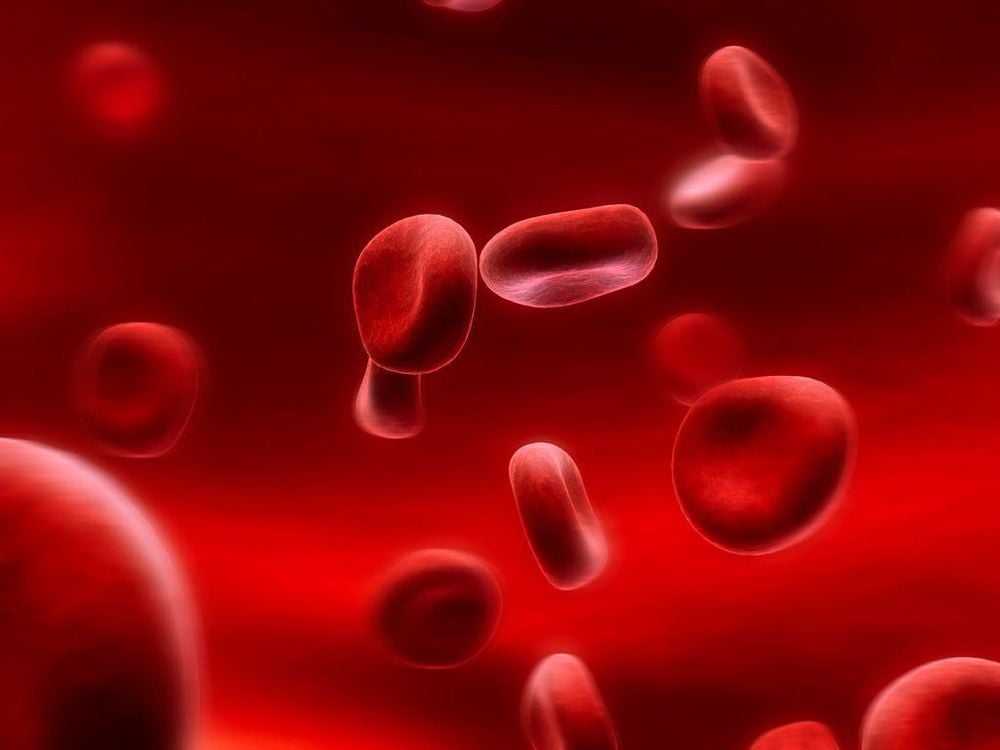Microcytic hypochromic anemia can share many characteristics with iron deficiency anemia or hereditary hemolytic anemia such as thalassemia. Because the symptoms of the disease are not obvious, it can lead to many complications for the patient. It can also cause severe damage to various organs in the body. In some cases, microcytic hypochromic anemia can even be life-threatening.
1. General information about microcytic anemia
Microcytic anemia is defined as anemia with red blood cells that are smaller than normal. At the same time, this condition is also accompanied by symptoms of decreased hemoglobin. When microcytic anemia occurs, it is characterized by an average red blood cell volume index MCV lower than 83 μm3. Hypochromic anemia reduces the oxygen-carrying capacity of red blood cells and leads to a lack of oxygen in the body's tissues.
Is microcytic anemia syndrome Thalassemia? Thalassemia is defined as a hereditary hemolysis, which is an abnormality of hemoglobin in red blood cells. Microcytic anemia can also be caused by iron deficiency or Thalassemia.
To determine whether the disease is microcytic hypochromic anemia, the following tests should be performed:
- If the anemia is due to iron deficiency, a test can be performed to determine whether the serum iron has decreased and to what extent.
- If it is due to Thalassemia, a test should be performed to determine whether the serum iron has decreased, and in some cases, the serum iron may even increase.
In cases of Thalassemia, molecular genetic methods can be performed to help determine the disease more accurately.

2. Symptoms and Signs to Identify microcytic hypochromic anemia
The initial symptoms of anemia may not be clearly defined and can even be quite difficult to recognize. In the advanced stages of the disease, there are signs that indicate a lack of red blood cells, which affects tissues in the body.
However, microcytic hypochromic anemia can be identified based on some common features. To ensure a more accurate diagnosis, additional tests are required.
- The patient may experience shortness of breath or an increased breathing rate.
- The patient may feel irritable.
- Dizziness may occur.
- The patient’s skin often appears pale or sallow.
- The patient’s heart rate may increase.
- The patient feels fatigued and weak and may even feel drained of energy.
- The mucous membranes of the eyes may appear pale, or the fingernails and toenails lose their pink color.
- The patient’s nails may have a spoon shape and are prone to breaking easily.
If these symptoms appear and do not go away within two weeks, the patient should consider seeking medical attention. It is especially important to consult a doctor as soon as possible if accompanied by dizziness or severe shortness of breath.
3. Possible causes of microcytic anemia
3.1. Causes due to iron deficiency
Iron deficiency is considered the most common cause of microcytic anemia. Iron deficiency often occurs in cases such as Pregnant women, whose daily diet does not meet the recommended iron requirement, or the body cannot absorb iron in food due to diseases such as celiac disease, and Helicobacter pylori infection. It can be due to chronic blood loss due to prolonged menstrual cycles with serious conditions in women, or due to gastrointestinal bleeding, or can also be caused by inflammatory bowel disease.
3.2. Causes due to Thalassemia
Thalassaemia is known for anemia caused by genetic mutations and causes a significant impact on the production of hemoglobin in the body.
3.3. Causes Due to Inflammation or Chronic Diseases
Inflammation in the body or chronic diseases can interfere with the function of red blood cells, affecting their role in the body. This may lead to a reduced absorption or utilization of iron minerals in the body.
Some chronic diseases that can contribute to microcytic hypochromic anemia include cancer, kidney diseases, and infectious diseases such as tuberculosis, HIV/AIDS, or endocarditis. It may also involve inflammatory conditions such as rheumatoid arthritis, Crohn's disease, or diabetes.

3.4. Causes of erythroblast anemia
Erythroblast anemia can be diagnosed due to congenital genetics or acquired genetic mutations. Erythroblast anemia often occurs when the bone marrow instead of producing normal healthy red blood cells, produces sideroblasts with red blood cell precursors containing iron in the mitochondria. Due to the condition of iron being trapped in the mitochondria, the body cannot combine iron to form hemoglobin needed to help cells transport oxygen.
3.5. Causes of lead poisoning
Lead poisoning is also classified as a cause of disease, especially diseases related to the blood. When you are poisoned by lead due to exposure to paint or gasoline containing lead or due to long-term exposure to other materials containing lead, it can cause microcytic anemia. Especially in young children.
4. Diagnosis of Microcytic Hypochromic Anemia
To ensure proper and timely treatment for microcytic hypochromic anemia, several diagnostic methods must be applied to accurately identify the condition.
Initially, the doctor may diagnose microcytic hypochromic anemia through a complete blood count (CBC). If the test results show anemia, the doctor will proceed with a peripheral blood smear under a microscope. This test allows the doctor to detect structural changes in red blood cells, such as enlarged or small red blood cells, hypochromic, normochromic, or hyperchromic cells, etc.
Once the doctor has diagnosed microcytic anemia, they will inquire about the symptoms the patient may be experiencing. Additionally, the doctor may order further tests to help determine the underlying cause of the microcytic anemia, such as abdominal ultrasound, CT scan of the abdominal area, or endoscopy of the esophagus, stomach, and small intestine. Upper gastrointestinal endoscopy may also be performed to obtain an accurate diagnosis.
In cases where the patient is a woman showing signs of pelvic pain and prolonged menstrual cycles, a gynecologist may perform additional tests to diagnose conditions such as uterine fibroids or other conditions that could be considered causes of heavy bleeding.
5. Complications of microcytic anemia negatively affect the body
Microcytic anemia can be dangerous for people with the disease. However, at the beginning, the patient does not feel the disease condition, possibly due to mild anemia, and does not affect the body's condition much. However, when the disease lasts for a long time and is not treated promptly, it shows that the patient's condition has abnormal signs affecting the internal organs. In addition, the disease can cause complications such as shock, which often occurs with hemolysis or acute blood loss; or problems related to the lungs, related to low blood pressure and body weakness, or problems with the coronary arteries, or even more serious can cause death due to the patient.
Complications due to microcytic anemia are often quite common in the elderly and have had diseases related to the lungs or heart.

6. Prevention and treatment of microcytic hypochromic anemia
The primary cause of microcytic hypochromic anemia is iron deficiency. Therefore, to prevent this condition, you can supplement iron according to the recommended daily intake for your body.
- A diet rich in iron is essential. You should choose iron-rich foods such as red meat, beef, buffalo meat, seafood, eggs, and green vegetables. It's also helpful to consume fruit juices containing vitamin C, which aids in better iron absorption. Additionally, you should include foods that provide vitamin B12, folic acid, and other micronutrients that support iron absorption to help prevent the disease. It is also advisable to limit the intake of stimulating drinks such as tea, coffee, beer, and alcohol.
- You should consider taking iron supplements to prevent deficiencies. You can choose an appropriate iron supplement to improve iron absorption, especially for pregnant women, as iron supplementation plays a crucial role in the normal development of the fetus and the mother's health. If taking iron supplements, you should consult with a doctor to ensure the supplementation is effective and does not negatively impact your health.
The treatment of microcytic hypochromic anemia depends on the underlying cause. After performing diagnostic tests, the doctor can establish a treatment plan, which may include: blood transfusions for severe cases; hormone supplementation to treat heavy menstrual bleeding; medication to stimulate the body to produce more red blood cells; surgery for treating conditions like gastric ulcers or tumors in the intestines; antibiotics to treat chronic infections that may contribute to anemia; or chelation therapy to reduce lead levels in the body for cases of microcytic hypochromic anemia in children.
In severe cases, iron infusion can be performed. However, this method can cause side effects such as anaphylactic reactions, serum sickness, thromboangiitis, and pain for the patient. This method can also be applied to cases where the patient is unable to tolerate iron or does not take iron tablets or the patient has lost a lot of blood due to vascular disorders. In these cases, the doctor will treat iron with the required dose for 6 months or more and at the same time adjust the hemoglobin level to supplement the body's iron reserves to meet the recommended needs.
Information about hypochromic microcytic anemia shows that hypochromic microcytic anemia has a significant impact on the patient's health, and can even be life-threatening for those with the disease. However, when you understand this disease and how to prevent it, it will help you prevent or treat it more effectively.
To arrange an appointment, please call HOTLINE or make your reservation directly HERE. You may also download the MyVinmec app to schedule appointments faster and manage your reservations more conveniently.
To arrange an appointment, please call HOTLINE or make your reservation directly HERE. You may also download the MyVinmec app to schedule appointments faster and manage your reservations more conveniently.








